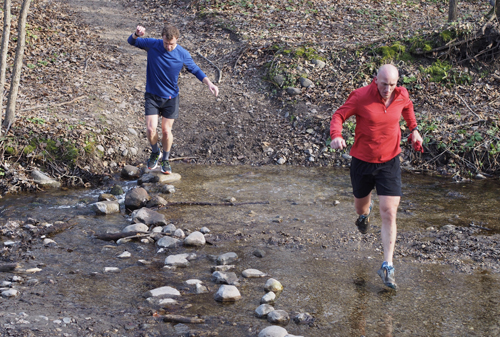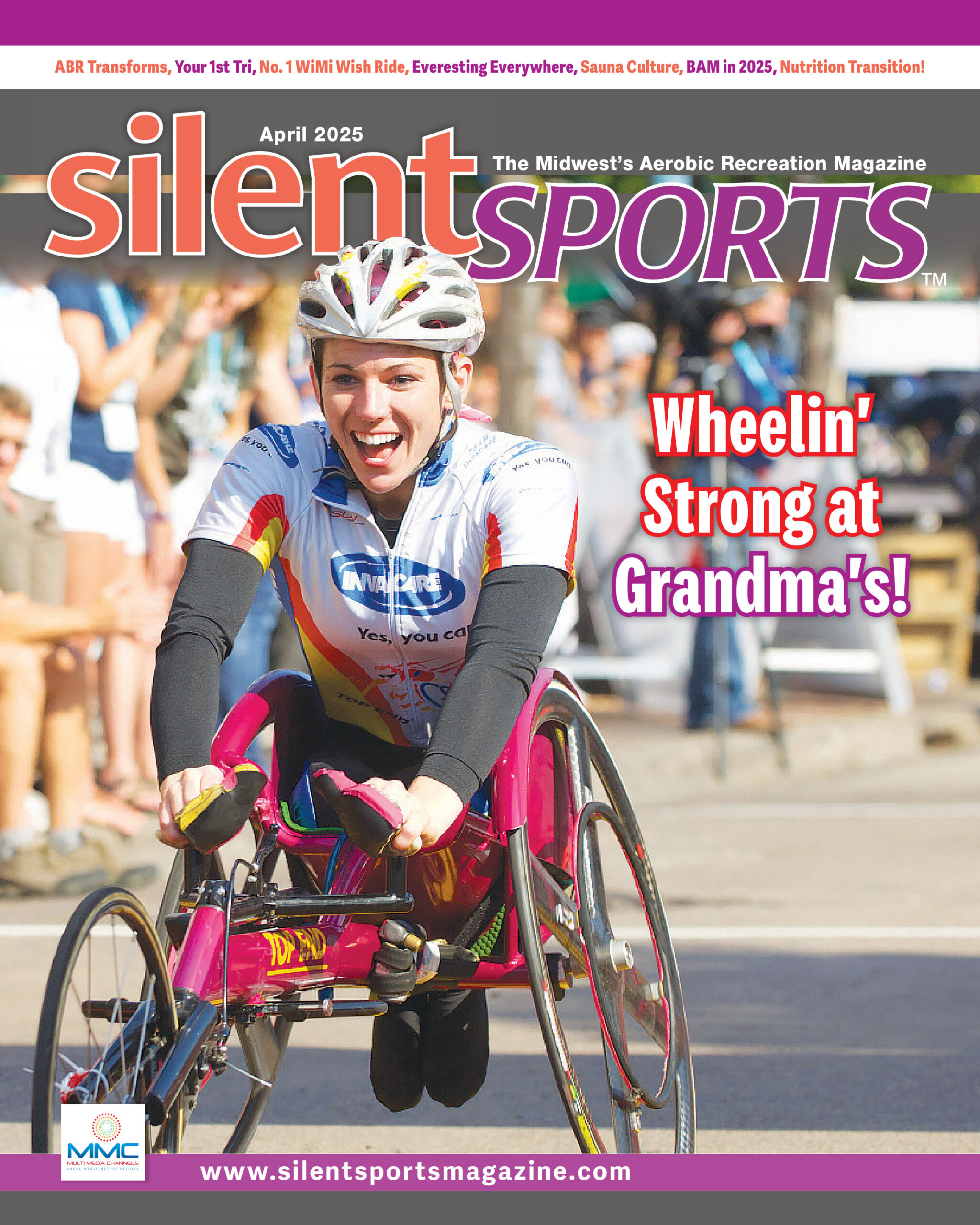Homecoming

Trail running with Kevin Langton
TJ and his dog Loki are already at the trailhead when I pull in. Little Dog growls and yips at my Jeep window. When I open the door, he jumps out. He’s a low hum circling and herding Loki. Little Dog is a miniature schnauzer with a shaggy cut, and Loki is a red American dingo mix at least twice the size of Little Dog. They dart up a wooded hill together as TJ and I cross the creek and begin our run on a gravel and sand trail.
It’s a beautiful and warm day in the late fall sun. It’s the first weekend that Seven Mile Creek Park – in St. Peter, Minn., north of Mankato – is open after being closed for many months. The highway leading to the park was shut down and raised over the summer because mudslides have repeatedly closed it. The park is our favorite local place to run and we’re excited about what we’ll find today. For all we know, the creek has changed course with so much summer flooding and it’s overrun the trails. Will there be new trails? Will our favorite trails be eroded and overgrown?
The creek here spearheads a watershed that drains into the Minnesota River. The valleys drop dramatically from the stereotypical flatness of south-central Minnesota corn and soybean fields. We find vertical here in our otherwise flat world. That’s why it’s such a favorite place to run.
“My legs have missed this,” I say.
“Everything in me has missed this place,” TJ says.
The park does that to us. It’s where we go to escape jobs and meetings and phones and schedules. It’s where we go to find ourselves and each other, to remind ourselves of what matters most. We run through the seasons, through early summer mornings and winter nights, through spring mud and fall frosts. We know the trees favored by porcupines and the movement of deer, and where the spring and fall mushrooms grow best. We’ve learned these things on our runs together here. This place is a part of who we are, not just as runners, but as humans, and we’ve missed it these last several months.
Signs of civilization are kept low in this county park. No trails are paved and they’re shared with mountain bikers and horse riders and whoever else wants to use them in whatever way they choose to use them. In the winter, skiers and snowshoers and dog walkers smash down the same ungroomed snow. Some creek crossings are bridged, but others require a bit of rock jumping or ankle wetting if the water’s high.
The dogs are having a blast, racing around sharp curves, running side-by-side, leaning into each other. We can see if other people are here through the leafless trees and the trailhead parking lot’s empty, so they’re running leashless, though we’re both carrying something to tie them up with if we need to. “Looks like they’ve missed being out here too,” I say. There’s something about watching your dog do what he’s made to do that fills the heart.
The trail climbs up the valley wall until we top out, and in the forest above we search for our preferred method of descent, an overgrown deer path. We know it’s around here somewhere, but it’s lost in leaves and downed branches. Then we spot it, just a trampling of grass and a slight indentation in the ground. It leads to a hogback ridge and we surrender to gravity and leap rotting logs and upturned roots. We stir fallen leaves and loose soil. We do our best to stay upright. The sound of water tumbling over rocks comes into play as we approach the creek again.
Soon we are climbing another hogback ridge on a single-track trail that’s suffering from water runoff and erosion. It makes me think of the Minnesota River Valley’s formation. The valley was created as Glacial Lake Agassiz drained. So often we think of how extended time slowly creates change, but this valley was dug out by an incredible water flow about two weeks after glacial ice dams busted and River Warren filled it. It’s a valley that’s over a mile wide in most places. The Minnesota River is just a small portion of the valley today, but Glacial River Warren filled it from side to side. That’s so much moving water, so much power, so much to consider. Our conversation is muffled by our desire for oxygen and we briefly rest on a point where we can see the canvas of trees that lead all the way back to the Minnesota River. We breathe in the autumn grays and browns. I try to imagine what early people thought as they watched the water rushing past from some dramatic overlook like this one.
TJ’s off without a word and I trail him up the steepest part of the climb, leaning into my racing heart and screaming legs. The nice thing about a great running partner is that we know each other when it comes to running. Although I sometimes forget what the T stands for in his name, I know that he belongs ahead of me on climbs, and he knows I like to bomb the descents, so he moves out of my way at the top. He knows that if I get quiet or unresponsive that I’m suffering some, but he also knows I like it when he keeps talking, that his voice becomes a string I can tie onto for miles. And when he gets quiet, I remind him to eat and fuel. We might talk about work or our families or our childhood memories, or we might talk about nothing at all. Our conversations rise and flatten like the countless trail miles we’ve covered together.
We’re not finding any major surprises here. The trails are much the same as we left them months ago. They’ve only been changed by the seasons and the elements. Soon we’ll be skiing these hills instead of running them and the creek will be frozen solid and crystals will float in the air. “I thought this would feel different or strange,” TJ says. “I thought running out here again would be weird, but it’s not.”
“Feels more like we were just here yesterday,” I say. “Like we never left.”
“Yeah,” he says. “That’s it.”
It’s like putting on a comfortable sweater we haven’t worn for months.
The dogs are wearing out and settling into a pace they could run all day. Little Dog finds his place just a couple steps behind me. His shaggy fur is covered in burrs and leaves. We stop at the creek and they stand in the water and pant and drink before we continue our loop.
Near the end of our loop, we meet another runner. It’s our friend, Toby, and we stop to chat. He’s just starting his run, and TJ and I don’t have to discuss our options. We ask Toby if he wants company and we turn around and follow him back around the circle we’ve just made. On our loop we’ll encounter horse riders and a couple other people celebrating the opening of the park. At the end, we’ll laugh and get into our cars with muddy shoes and dirty dogs and we’ll drive home and the world will seem right again.




